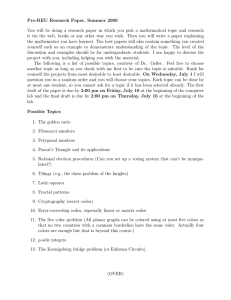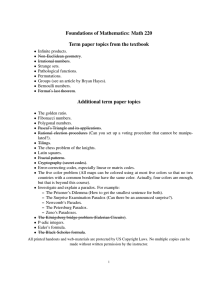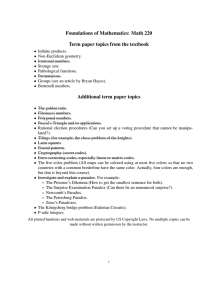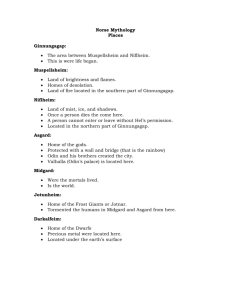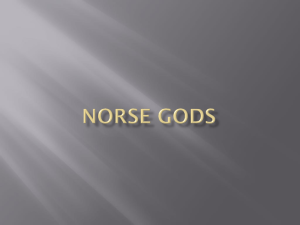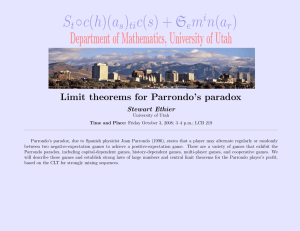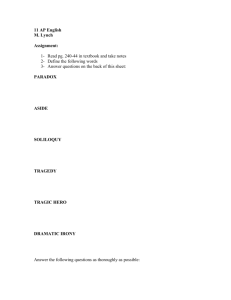The Paradoxes of Situations in the Work “Odin Mondvalsen”
advertisement
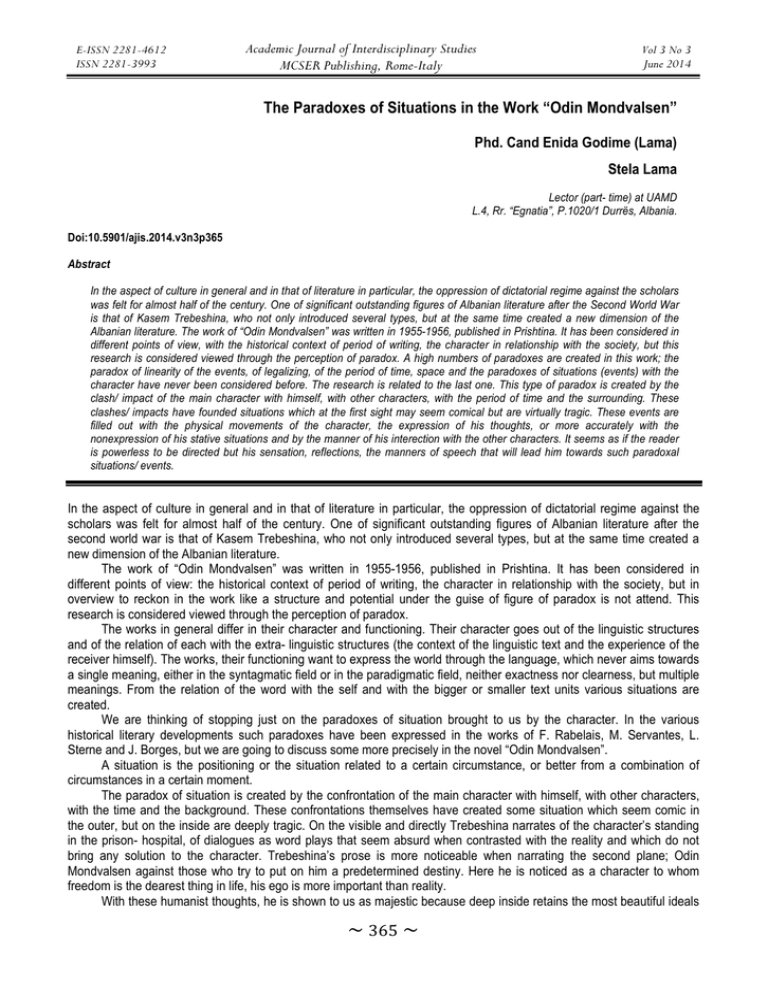
E-ISSN 2281-4612 ISSN 2281-3993 Academic Journal of Interdisciplinary Studies MCSER Publishing, Rome-Italy Vol 3 No 3 June 2014 The Paradoxes of Situations in the Work “Odin Mondvalsen” Phd. Cand Enida Godime (Lama) Stela Lama Lector (part- time) at UAMD L.4, Rr. “Egnatia”, P.1020/1 Durrës, Albania. Doi:10.5901/ajis.2014.v3n3p365 Abstract In the aspect of culture in general and in that of literature in particular, the oppression of dictatorial regime against the scholars was felt for almost half of the century. One of significant outstanding figures of Albanian literature after the Second World War is that of Kasem Trebeshina, who not only introduced several types, but at the same time created a new dimension of the Albanian literature. The work of “Odin Mondvalsen” was written in 1955-1956, published in Prishtina. It has been considered in different points of view, with the historical context of period of writing, the character in relationship with the society, but this research is considered viewed through the perception of paradox. A high numbers of paradoxes are created in this work; the paradox of linearity of the events, of legalizing, of the period of time, space and the paradoxes of situations (events) with the character have never been considered before. The research is related to the last one. This type of paradox is created by the clash/ impact of the main character with himself, with other characters, with the period of time and the surrounding. These clashes/ impacts have founded situations which at the first sight may seem comical but are virtually tragic. These events are filled out with the physical movements of the character, the expression of his thoughts, or more accurately with the nonexpression of his stative situations and by the manner of his interection with the other characters. It seems as if the reader is powerless to be directed but his sensation, reflections, the manners of speech that will lead him towards such paradoxal situations/ events. In the aspect of culture in general and in that of literature in particular, the oppression of dictatorial regime against the scholars was felt for almost half of the century. One of significant outstanding figures of Albanian literature after the second world war is that of Kasem Trebeshina, who not only introduced several types, but at the same time created a new dimension of the Albanian literature. The work of “Odin Mondvalsen” was written in 1955-1956, published in Prishtina. It has been considered in different points of view: the historical context of period of writing, the character in relationship with the society, but in overview to reckon in the work like a structure and potential under the guise of figure of paradox is not attend. This research is considered viewed through the perception of paradox. The works in general differ in their character and functioning. Their character goes out of the linguistic structures and of the relation of each with the extra- linguistic structures (the context of the linguistic text and the experience of the receiver himself). The works, their functioning want to express the world through the language, which never aims towards a single meaning, either in the syntagmatic field or in the paradigmatic field, neither exactness nor clearness, but multiple meanings. From the relation of the word with the self and with the bigger or smaller text units various situations are created. We are thinking of stopping just on the paradoxes of situation brought to us by the character. In the various historical literary developments such paradoxes have been expressed in the works of F. Rabelais, M. Servantes, L. Sterne and J. Borges, but we are going to discuss some more precisely in the novel “Odin Mondvalsen”. A situation is the positioning or the situation related to a certain circumstance, or better from a combination of circumstances in a certain moment. The paradox of situation is created by the confrontation of the main character with himself, with other characters, with the time and the background. These confrontations themselves have created some situation which seem comic in the outer, but on the inside are deeply tragic. On the visible and directly Trebeshina narrates of the character’s standing in the prison- hospital, of dialogues as word plays that seem absurd when contrasted with the reality and which do not bring any solution to the character. Trebeshina’s prose is more noticeable when narrating the second plane; Odin Mondvalsen against those who try to put on him a predetermined destiny. Here he is noticed as a character to whom freedom is the dearest thing in life, his ego is more important than reality. With these humanist thoughts, he is shown to us as majestic because deep inside retains the most beautiful ideals ~ 365 ~ E-ISSN 2281-4612 ISSN 2281-3993 Academic Journal of Interdisciplinary Studies MCSER Publishing, Rome-Italy Vol 3 No 3 June 2014 of humanity. He preserves the freedom he seeks and never finds in the surrounding, so he closes to himself. The communism encountered in the first pages of the book develops until it reaches the grief and ends to tragic. In fact we feel necessary to make clear that Odin Mondvalsen inside is characterized as a man of absolute clarity. If he didn’t have this clarity, we wouldn’t have any Odin Mondvalsen. Despite the outer look of a man suffering from schizophrenia to a reader of the first level, he in fact is not such a man. He is neither tormented by Hamlet’s “to be or not be”, or by Don Quixote’s obsession of fixing the world; he becomes a tragic victim not because of his intentions, but due to others’ continuous attempts of destroying him spiritually. Schizophrenia is a mean of creating a second reality as a cover from the first sad reality. In the relation with himself exist simple paradox, logical kind. Odin Mondvalsen work begin with the character going to the moon to look for a donkey. In the middle of difficulty vital conditions he creates sexual relation with a woman who look as a nurse, as a trap of system where he lives, as a lover etc. In the middle of dictated discussions he succeeds to tell the readers what he really feels and thinks about the system where he lives. In relation to “the others” that come and go, Odin Mondvalsen creates more powerful paradoxes. Someone appoints your words, someone never accepts the right opinions. Despite the choice of words by someone else, we are of the opinion that the mass of opponents is so big that it passes to many. In what relation to the others is Odin Mondvalsen? The others form a communion bigger than the one possessed by Mondvalsen. In this communion, its members are not “members” of themselves. They are continuously shown as members of a certain communion and not as individualities. In a surrounding of prison hospital, in an unspecified time the conflict is accomplished: communion vs. Odin Mondvalsen. From the point of view of the communion, they must look for the truth, but then it comes a moment when it is not important anymore if Odin Mondvalsen is telling the truth or the wrong. If he is saying the truth, the communion cannot accept it without punishing him, if he is not telling the truth he will be punished because he lied. From Mondvalsen’s point of view it doesn’t matter whether he is telling the truth or not. If he is telling the truth the communion has to free him because the truth is what they are looking for and in the end this is his only truth. If he is not telling the truth he must be freed because there is nothing to be said. Their non-coherent conflict can be analyzed in the form of the following arguments: The communion can say that: - If Odin Mondvalsen says exactly who he is and his actions, then he must be freed, because the truth is what we are looking for. - If we free him, then Mondvalsen is not getting his punishment. - But he cannot go without punishment. Odin Mondvalsen can say that: - If I say who I am exactly and what I represent, then I will be punished. - If I am punished I have said exactly what they want to hear. - So I have to be freed because they don’t have anything to look for in me, I am not telling what they want. The paradox remains whether you must express yourself or express what they want to hear; finding what “they” want. In this paradox of situation there is a similarity with Eumenides paradox “the crocodile’s paradox”. Based on a pragmatic choice: Whatever Mondvalsen does, the communion is not keeping its word. If they imprison him, it means that Mondvalsen was telling the truth, but they don’t either accept his truth. It seems like a going paradox, without any choice. Even if without knowing we imagine Odin Mondvalsen a free man, it comes without solving the paradox between them. If the empiric reader identifies himself with Mondvalsen, the truth is not important any more, freedom becomes important. This seems like being accomplished in the end, but no; the communion has achieved his spiritual punishment. It killed the dream. A careful reader would notice that the dialogue between the others and the main character is one of the means that in different situations creates empty spaces, i.e. the dialoguing exchange is mainly one way and it does not include both speakers. The intertwining between the two roles: the speaking subject and the listening one, does not function naturally because there happens to be only the speaking subject and the imaginary listener, but not an alternation of the two speakers. “I got up, went to the door and opened it: the hall was deserted. Where had she gone? … What was happening to me?” (p. 100) In the communicative situations the message does not usually get to the real speaker, but to an unreal speaker, that does not talk. “… why didn’t he speak when I had said several words and needed to hear a clear friendly word about what I had said?” (p. 91) ~ 366 ~ E-ISSN 2281-4612 ISSN 2281-3993 Academic Journal of Interdisciplinary Studies MCSER Publishing, Rome-Italy Vol 3 No 3 June 2014 In such situations the two ways of the dialogue do not function the way they should because the aggressive subjectivity of one character does not allow for the other’s world to be expressed in a natural dialoguing way: “… write!ordered the investigator his secretary . –We came to the new world for weak spying ends.” (p. 83) Still it is not the problem of the dialogue in the book that we are discussing here; we are drawing attention on the fact that this dialogue is the means that points out the paradoxical situations in the book. Some internal sentence structures change the dialogue to both a formal and a thematic problem. About the formal problem, we believe we are dealing with a metalogue, which means that on a problematic argument over which the whole dialogue is built, functions on at least two levels, on conversation and on “subconversation” (on getting to know the character’s internal world), in the real world there misses the real normal communication with “the others”. The repetitions, the pauses, the stubbornness, the violent replies, the ironies do only function dialogically, but they suggest different states even psychological: frustration, violence, submission and rebellion. From the way the sentence is constructed, from the exchange of the dialogue there are found internal tensions, confrontation of forces and powers between Odin Mondvalsen and the “others”, that it can be noticed an absence of a mutual code. This is the paradox of artistic creation and discourse of the novel: if the dialogue or dialoguing happens, it might also have been accepted as a part of not normal structures. For most readers their first attraction comes from his personality, a relation they find between the main character and themselves. A relation, whom is not find to the normal life either. When we discuss about the character into the terms of literature art, we are talking for the personality of the character, his intellectualities ability; for the techniques that is used to create, develop and showed the character to the reader; and the last if the characters are reliable and obedient In a work of art the characters may play different roles: protagonist and antagonist, but this is not an exact definition starting from a character’s positive and negative values. It is from here that begins the first paradox: the character’s protagonism and antagonism. Odin Mondvalsen, in the eyes of the reader remains undoubtedly the protagonist of the events, the one that holds the positive values, but this does not happen in the eyes of the others. He is labeled a spy: “write! -said the investigator, - I’ve come here for weak spying ends.” (p. 83); he is investigated a guilty man –he is even presented as such since the first chapter; he is sentenced, freed and persecuted. A naïve reader may see this character as a mad man who cannot adjust himself to this New World. Antagonism is often hard to spot, especially when it is spoken about a big, unidentified amount and about an abstract force. This is the first case of unidentified evil characters, in which they come as a mortal mass, which moves to draw you into their lava. The roles are reversed through paradox; crime and justice are put face to face, but alienated from the situation the reader pretends. The criminal - Odin Mondvalsen (a human) The judges - Criminals The justice - Crime The crime – Justice The political criminal, according to the judges: it is his crime calling himself Danish while being Albanian. His proclamation implicates the wish for freedom. This right is the most human right, but it is misinterpreted by the huge mass of “the others”. It is in this context that Justice forbids the expression of free opinion. Thus the judges are inhuman and criminals. Odin Mondvalsen is the most normal among them. In order to describe the relationship of how the creator develops the characters, E. M. Foster writes about flat and round characters. The flat characters are those which are presented with a limited characteristic, feature or idea or with a list of very limited qualities. These characters are known for their incompleteness, their appearance and their mannerism. These characters are unchangeable; they have the same attitude throughout the book. The round characters are the opposite of them. They hold a number of qualities and features, are multifunctional, but this does not mean that they are most preferred by the writers. Being a round character means to take time and space and to be expanded largely in a work. They often considered as dynamic characters. We think that in this stands the second paradox of the character: to be a flat character or to be a round character. Our character at the beginning presents himself as a flat character, without any dilemma. The main leitmotif “I’m Danish” is enough for him. This is the way we get to know his unchangeable attitude, even though he is presented problematic to the others; from the moment we are presented with his attitude, his thoughts are expanded in time and space, either real or hypothetic. In the beginning the main character is presented to us a flat character, without any dilemmas, the main leitmotif “I’m Danish” is enough. This the way we are presented with his unchangeable attitude, even though he shows himself as problematic to the others; from the moment we are presented with his attitude, his thoughts are stretched in time and space, either real or hypothetical. In the beginning his character is shown as rejecting cooperation, but then in the way he changes for the sake of love, but not in his convictions. The disclosure of this character happens from his name, which holds the essence in his characterization. The name is in accordance with his attitude, which sounds as ~ 367 ~ E-ISSN 2281-4612 ISSN 2281-3993 Academic Journal of Interdisciplinary Studies MCSER Publishing, Rome-Italy Vol 3 No 3 June 2014 foreign to the Albanian world. His physical appearance is not mention anywhere in the novel; everything comes from the spiritual world. Apparently, it is not Trebeshina’s intention to attract attention towards one character only. He intends to generalize this character, the same as it happens with the other characters, which do not have a name in the works of art. The third paradox: a hero or an antihero? The main character consists of one protagonist, the distinctive traits of which are directly contradictory, incompatible with the traditional traits of a hero. This contradiction does not mean that the character is a devil or a malefactor, but in fact it frequently tries to reflect the author’s conviction that in modern life he does not tolerate or produce individual capabilities of real heroism in the classical sense. (James H. Pichenin, Jeffrey D. Haeper. 1986) The term antihero comes from the creation of antinovel, a new genre which came out against the classical novel. It destroyed the subject, narrowed the character’s space in its structure; it even used pronouns, initials and conventional signs instead of real individualizing names. This type of novel gives importance to the formal structure of the novel as well; it destroys its causal, chronological course to emphasize the absurd character of the world. The antinovel became a fragmental registration of feelings, reflexes, impressions, memories, hallucinations, which do not give any information from social life. In the classic types of novels, heroes are decisive leaders of their people, hold their ideals, while antiheroes tend to be lonesome, without any perfectionism, they are barely capable of survival. Antiheroes can be distinguished by psychologists for their lack of character; solitary persons who do not know what to do with their lives. The paradox stands in the way Odin Mondvalsen bears the characteristics of a certain social group as well: has his ideals, knows very well what to do in his life, even though he is in the role of an insane, he bears Trebeshina’s ideals as well, but on the other side he is also an antihero: we know him in a particular moment in his life, the events are not given chronologically; they are given distorted and the love story is presented as a dream of the main character. The drama in this novel is focused in the life of one character. The words are presented in wordplays to prove the hero’s existence. “I speak, that’s the way I am,” say these tireless heroes, condemned till their last breath to shuffle words. In the form of the fantastic, of memories or ordinary “stories”, the word is their pleasure, but at the same time is their lightening as well.( Storia della litteratura francese, 1985) The word in this book has double functions: it is the character’s fullness and his emptiness, it is his torture and salvation, it is both his weakness and his greatness, that’s why it is created as an endless paradox in his world. What is tragic about Odin Mondvalsen is that he stays inside his own life, in a waiting that never comes, in incomprehensibility in an empty world that repeats itself and restarts without an end, which is also reflected in the novel’s structure. Living is like walking forwards and backwards, without any sense, being condemned to stay at the same place with eyes wide open as you may become someone’s prey quickly. Tragedy does not have to do with the end, but with the never stop finishing. So Odin Mondvalsen cannot succeed with the ones surrounding him, he wants to save himself, but not by escaping aimlessly; but still he is convinced that even if he escapes he will be found by the “others”. Meanwhile he creates another imaginative world, which is showed by the subtitle: “A history of love”, but in the end he falls down. The world of Odin Mondvalsen, could not be known by the reason because it goes beyond its. Everything comes known through intuitive that is helped by the context. The character shows negativism to everything, approaching to the antihero than to the hero. Forth paradox of the character consists between the truth and laughter that can be created from the character. Odin Mondvalsen builds the image the hilarious, the silly and the foolish too. However, he creates the image of the person who tell the truth and has the most possible tragic ends. Michael Bachtin says that these kinds of character take place in popular squares (related with folk literature), their existence has not a direct significance, but metaphorical and often reverse from what is showed. At the same time with these roles the character hit who attend to usurps till the dignity. The character is allowed only a thing in this world: being e foreigner. He does not agree in any condition of life, because the agreement looks like going back in to lie. So he faced these conditions through masks to win the right and the minimal privilege: the living. In this role the reader may laugh, but is created at the same time the parodic laughter. Our man exists in life passively, watching and reflecting from the inside and the only contact with life is by playing other roles: the hilarious, the silly and the foolish. But the roles in the way overthrow; all the institutions become fictitious and hypocritical, while real life is transformed into animal and dull. Thus there can be noticed various transformations; in the fight against conventions the mask holds extraordinary meanings: it is the character’s right not to understand, to misunderstand, to mime, to hyperbolize life; the right to speak burlesquing, not to be himself, the life to live his life under this fixed and closed cronotropismos, the right to unmask the others, the right to curse together with the cursed and in the end the right to proclaim his private life with its most intimate secrets. ~ 368 ~ E-ISSN 2281-4612 ISSN 2281-3993 Academic Journal of Interdisciplinary Studies MCSER Publishing, Rome-Italy Vol 3 No 3 June 2014 Through these roles Odin Mondvalsen succeeds to see into his inner side; succeeds not to surrender, to fight and in the end accept his destiny. The world presented in this novel (even though we are aware that it is not the world in itself but the Albanian reality) is totally degraded, a foreigner to everything related to a motherland. The hero remains attached to the moral and social values and indirectly it is presented not only the spiritual decadence of the main character, but that of the world; Lukacs defines this world as “demoniac” (Giorgy Lukacs. 1999) that comes contrary to the positive, divine term. Lukacs continues that in such societies the main character of the novel is a problematic person, an insane or a criminal looking for absolute values without fully knowing them and thus never getting near them, but our character is such a man not because he is looking for values, but because they are disappearing, are alienating and their non-existance causes his moral failure. The fifth paradox is the character’s absurdity and naivety. Where is the line dividing the absurdity and truthfulness of this character? There seems not to be a dividing line: there where there is the absurdity, there stands his truthfulness. According to the dictionary of literature the absurd is a philosophical notion expressed by Camus in the 1942‘s “Myth of Sisyphus” and firstly conceived by Sartre’s “To be or not to be”. The absurdity describes the feeling that rises from the detachment of the man from the world and from ruining of any type hope. The feeling of absurdity does not rise from the simple investigation of a fact or impression, but instead it derives from the contrasting between a factual state and some type of reality, from an action and the world that exceeds it. The absurdity is essentially a divorce. It is not in none of the elements of contrast. It rises from their confrontation. (Le dictionaire de literature, 2002) In the end of the book his whole existence goes towards an undoing to end in some type of agony, which is endless; which makes stop living senseless, but going on living is also senseless. The character enters an endless equivocal. He now has the characteristics of absurd heroes, who end up tragically. The tragic hero is problematic and contradictory. He is willing to deny himself by questioning lots of social or moral practices of the time. (Le dictionaire de literature, 2002) Here stands the contradictory essence of Odin Mondvalsen: he assumes the characteristics of the absurd hero, but retains himself, his identity as inalienable. In absurd situations that deepen and as always don’t find a solution (because otherwise we would not have an absurd) we understand that: - He is important because he holds opinions of such greatness that he cannot express himself, but instead he considers himself for the reader to be unimportant; - He is a man who gives judging opinions for the others, but he pretends to be a mad man; - He often seems to be without any personality, but he is of more personality than all the other doctors and investigators that wander around him; - His language creates impossibility of communication with the others, but he and the reader communicate very well. From absurd come three consequences: revolt, freedom, passion. The revolt of Odin Mondvalsen seems when he rejects openly or tease the others with irony, linguistic parody. Freedom is the center of all his actions, is the ideal that has been violated, while his great passion is for being free to tell and feel what he wants and not what others want. In this flow the plot lose gradualness and the past, present, future garble and become a mess which ignore its flow in a direction, the event happens anywhere and everywhere. So the action is located in a close environmental, bare from the characteristic concrete because important is the idea that the most crush the “small man”. As much as the main character tries to escape from this situation, more he understands that absurdity is unavoidable. Absurd works are distinguishable for their lack of action. The inability to act is one of the main motivations of these kinds of works. Odin Mondvalsen is not characterized by actions, on him we find the actions of the others; he tries, but he never attains any goals. In the end we mostly see him submissive to this reality that strangles every sane thing that has opposing points of view. The reality remains the same in the end as it was at the beginning of the book: incorrigible, violent and of omnipotence. The evil continues to live. Another paradox within this point is also in the interrelation life – death. In absurd works there dominates a suffocating atmosphere of death, at such a point so that death seems to be better than life. The killings and suicides overload the pages of such books, while the paradox in our novel is that there is in fact a homicide, but one created by the others, it is not of someone’s wish, but imposed by the others. The meaning of this action is killing the hopes, wishes, changes of the man who does not share the same points of view as the system. The sixth paradox of the main character is in the interrelation myth – anti-myth. There has never been seen a crazy, foolish, silly, stupid, imprisoned and marred character tell the truth better than anyone else. A character that mocks the personalities of his time through the names of historical personalities, who have become myths of history and literature as for instance Sultan Murad II, Sultan Mehmed I, comrade Skanderbeg, Ali Pasha of Tepelena, Miladin ~ 369 ~ E-ISSN 2281-4612 ISSN 2281-3993 Academic Journal of Interdisciplinary Studies MCSER Publishing, Rome-Italy Vol 3 No 3 June 2014 Popović, Dušan Mugoša, Moisiu I Dibres, the Great Academic etc. The relationship between him and these characters are in the least good: he discusses with them, they provoke, irritate him and make him look at the wall. This is the given solution. The historical events are transformed into “small” characters that can transform another person’s world. The portraits of myths instead of the respect they must bring, create fear, panic and no solution to the situation Odin Mondvalsen encounters. Despite the created paradox, the aim is obvious: the smoothening of differences between the different social and political ages and countries. Odin, the Nordic myth, the one giving the title to the book, the most modern novel of Trebeshina, is a foreign myth on purpose. Trebeshina himself admits the ruining of the myth. (Edmond Cali, 2006) The seventh paradox based in the outlook of the character and the relations that he builds with the others, is the type or antitype Orwellian. Most of the Albanian critics have specified Odin Mondvalsen like Orwellian type. The violence that is treated in both works comes from the totalitarian systems and can bring “the metamorphoses” of the character, but exist some differences in these works. Odin Mondvalsen orients the readers to internal cognitive mechanism, to his psychoses, while Orwell leads the readers to recognize an external mechanism, the arrival and transformation of government officials. The violence to “the Animal’s Farm” is treated in the aspect of collective destruction, while to “Odin Mondvalsen” there is a individual spiritual devastation as much as it seems that the head and the body belong different dimensions. The body of character is in a limited space, while the head is far away. He does not travel in time, stays in a place. The time and histories of different places come to him to give the same image of violence. In the end it is worth mentioning under these circumstance there is no doubt that the character of Odin Mondvalsen is at the same time the most paradoxical and clear character ever created in the Albanian literature, especially during the years of the socialist realism. References Bachtin, Michael. Estetica e romanzo, Einaudi, Torino, 2001. Berto, Franceso. Teorie dell’ assurdo, Carocci, Roma, 2006. Cali, Edmond, The myth in Kasem Trebeshina, in the international seminar of the Albanian language, literature and culture, The Faculty of Philology, Pristina, 2006 Camus, Albert. The myth of Sisyphus, translated into Albanian by Petrit Sinani, “Fan Noli”, Tirana, 1996. Chatman, Seymour. Story an discourse. Narrative structure in fiction an film. Cornell University press, New-York, 1980. D’agostini, Franca. Paradossi, Carocci, Roma, 2009. James H. Pichenin, Jeffrey D. Haeper. Literature, Second edition, Macmillan Publishing Company, New York, 1986. Le dictionaire de literature, 2002. Lukacs, Giorgy, Teoria del romanzo, Se, Milano, 1999. Sinani, Petrit. The absurd, modern tragedy of destiny, Dituria, Tirana, 1996. Storia della litteratura francese, Dalla fine dell’ottocento a oggi, Garzantti Editor, Milano, 1985, p. 370. Trebeshina, Kasem. Legjenda e asaj qe iku. (Odin Mondvalsen). Shtepia botuese e lidhjes se shkrimtareve, Tirane, 1992. Voorhees, Richar J., The paradox of George Orwell, Purdue University press west Lafayette Indiana, Indiana, 1986. ~ 370 ~

